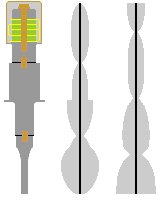
Sound waves are mechanical vibrations in a solid or fluid. Ultrasound is the same, but at a frequency higher than the range audible to humans - the lowest ultrasonic frequency is normally taken as 20 kHz (20,000 cycles per second). The top end of the frequency range is limited only by the ability to generate the signals - frequencies in the gigahertz range (upwards of 1 billion cycles per second) have been used.
Ultrasound has been used for a huge variety of applications, but for convenience I propose to divide these into two broad categories: low- and high-power ultrasound. Low power applications include medical imaging (e.g. scanning the unborn foetus) and non-destructive testing (e.g. regular crack-testing for aircraft structures). Notice that in both of these cases it's kind of important that the ultrasound doesn't have any significant effect on the subject of the scan... By contrast in the high power uses (described on the applications page) we are using ultrasound because it does have some effect. This site, as the name implies, is all about the power ultrasonics applications. I'll come to the effects shortly, but first let's look at some figures.
High power applications tend to use frequencies at the low end of the spectrum (i.e. from 20 kHz to about 100 kHz). This is because the power available is limited by mechanical stress in the vibrating parts (more about this later). Conversely higher frequencies (and square waves or step functions that include high frequency harmonics) tend to be used in measuring applications because the shorter wavelength offers greater accuracy, and at low power mechanical stress is not a problem.
To maximise the effects, high power applications often use as much amplitude as possible - in practical terms you turn the amplitude up until something breaks, or you run out of power! Typical amplitudes range from about 5 to 50 microns (that's 0.005 to 0.05 mm, or 0.0002 to 0.002 inches). It doesn't sound like much however you measure it, but think about this: An ultrasonic system operating at 20 kHz and 50 microns is moving with a cyclic acceleration of 80,000 g (eighty-thousand times the force of gravity). Can anything else on earth match that?
One minor point about amplitudes: There's a convention within the ultrasonics industry to quote amplitudes in "peak-to-peak" terms. This gives a figure of twice the amplitude as it would be defined by engineers, physicists and indeed the rest of the world (i.e. mid-point to peak). On the assumption that most people reading these pages will not be ultrasonics specialists I'm using the true amplitude here - if you feel the need for a peak-to-peak figure then double it!
To keep up all this frantic movement you have to supply some power (but surprisingly little in well-designed equipment). Typical power supplies have maximum outputs ranging from a few hundred watts to several kilowatts, but almost invariably have an automatic regulation system which supplies just enough power to maintain the vibrations at the specified amplitude. This is often called "power by demand".
